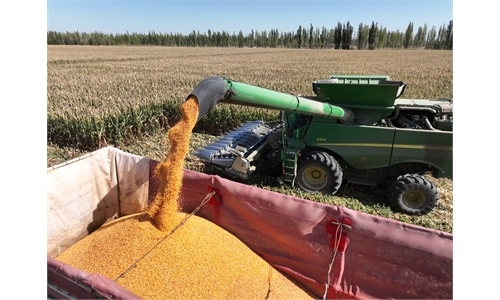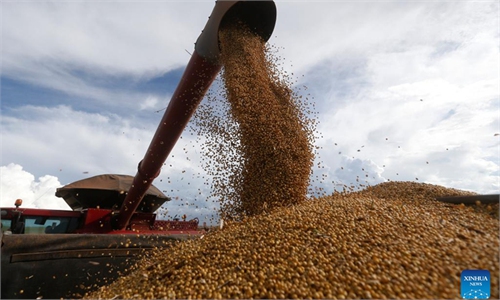China's annual grain output expected to hit new high, remain above 650b kg for 9th consecutive year: official

Farmers dry corn in Nanguanbei village, East China's Shandong Province, on October 23, 2023. Photo: VCG
China's annual grain output is expected to hit a record high in 2023, with a total of more than 1.3 trillion jin (650 billion kg) for the ninth consecutive year, while the output for the autumn harvest is set to increase, the Ministry of Agriculture and Rural Affairs said on Monday, assuring the nation's food security.Most regions that produce autumn grain crops received an agreeable balance of sunlight, temperatures and irrigation, even though some had experienced natural disasters.
The total sown area for autumn grain crops expanded this year, Zeng Yande, an official with the ministry, told a press briefing, and the summer grain output reached 292.26 billion jin, the second-highest level ever.
As of Sunday, some 81.3 percent of China's autumn grain crops had been harvested with most provinces achieving growth, Pan Wenbo, another ministry official, told reporters. The planting area for autumn grain crops this year is expected to reach 1.31 billion mu (87.33 million hectares), up 7 million mu over the previous year.
Experts and officials attributed the growth to a larger planting area and an improvement in yields, especially for major crops such as corn and soybeans.
The soybean cultivation area remained steady at more than 150 million mu for a second consecutive year, while the planting area for corn is estimated to have increased by more than 13 million mu.
There's been a surge in yields for corn, which is in strong demand domestically, Li Guoxiang, a research fellow at the Chinese Academy of Social Sciences, told the Global Times on Monday, adding that the corn crop was hundreds of billions of tons higher this year as a result of better yields.
Corn prices remained strong in recent years, motivating farmers to plant more, Li said.
The agriculture ministry aims to boost the per-unit yield for major crops. That policy affects 200 counties for corn and 100 counties for soybeans, and the central government has allocated 2.4 billion yuan ($328 million) to support relevant measures, according to Pan.
Pan said that higher total output in those 300 counties contributed 73 percent to this year's overall grain harvest, offsetting the impact of floods, drought and other disasters.
Experts said that high productivity, combined with abundant reserves and effective controls, had enabled China to respond effectively to global price fluctuations.
Bumper harvests in China in recent years and relatively abundant reserves have guaranteed the nation's food supply, Pan said. He added that domestic food prices have been basically stable despite surging and volatile global prices during the COVID-19 pandemic.
Li said that support policies and insurance also contributed to high grain productivity and enabled the country to firmly hold the initiative on grain security.



